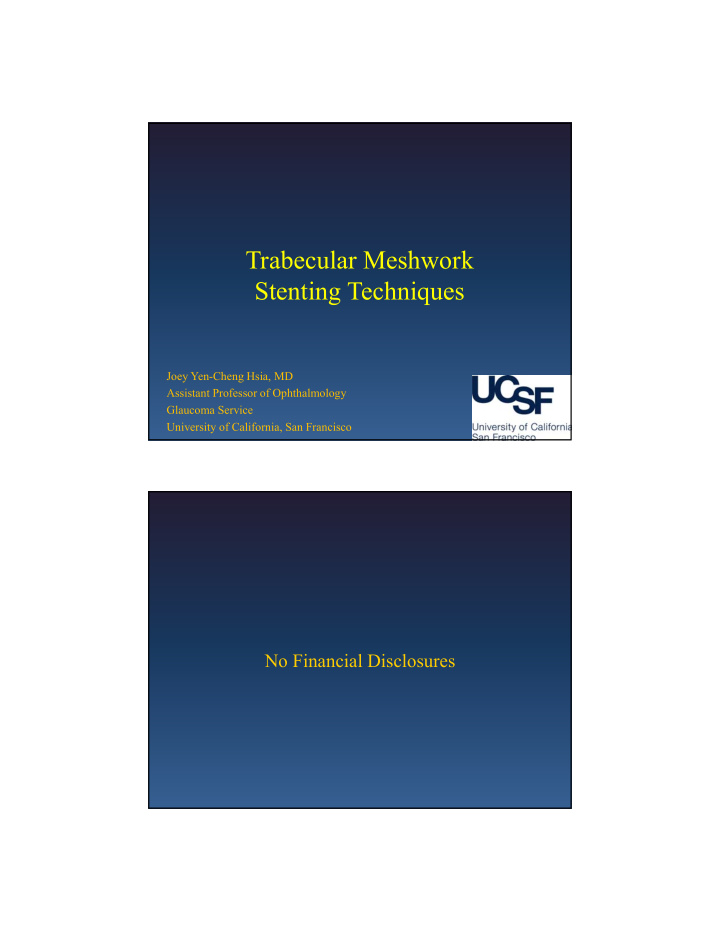



Trabecular Meshwork Stenting Techniques Joey Yen-Cheng Hsia, MD Assistant Professor of Ophthalmology Glaucoma Service University of California, San Francisco No Financial Disclosures
Introduction • TM bypass stent targets the by creating unobstructed aqueous flow to the Schlemm’s canal • Approved to use in for • Low learning curve Courtesy of Ronald Fellman, MD Conventional Pathway
Intraoperative Predictors – distal collector channels – patency iStent (Glaukos)
iStent inject iStent infinite Samuelson et al. Ophthalmology 2019
Hydrus Microstent 1. Aqueous bypass 2. Schlemm’s canal scaffolding The Horizon Study. Samuelson et al, 2019
Surgical Techniques and Pearls Optimize Your View – Temporal clear corneal incision – Make corneal incisions more anterior – Minimize corneal stromal edema – Open femto LRI / AK after stent placement 2. Use dispersive OVD under the gonio prism 3. Fill the chamber with cohesive OVD – slightly supraphysiologic level ∘ and microscope, adjust 4. Tilt patient’s head away from you ~30 accordingly
Shift incisions slightly anterior to reduce bleeding A bleeding wound will compromise your view and prolong surgical time!
Ergonomics • Sit comfortably and stabilize your hands • Place your finger on the release button, • Be mindful of the tilt and angle Volk Transcend your instrumentation Vold gonio prism appropriately while entering the eye • Lay the gonio-lens gently on the cornea to avoid corneal striae Pre-deployment • Ensure you have good view to the angle, patient’s head or microscope and apply additional to push back the iris or to clear any heme Pigmented TM • Identify TM from (CBB - Scleral spur > SS -> PTM -- highlighted by blood reflux) • Target area with most blood reflux or pigmentation
iStent • Engage the TM at ~15 ° angle with the tip of instrument then flatten – (landing an airplane) • Once inserted, tap the snorkel to ensure proper placement and depth Superficial implant in scleral spur • dislodged implant can • Remove and replace be retrieved with the mal-positioned inserter or micro- implant forceps
iStent inject • Apply gentle pressure (small dimple) for deployment • Straighten trocar during delivery • Aim for 2-3 clock hours apart or area of greatest blood reflux • Displace the blood to confirm a secure placement iStent inject • Retrieve dislodged or superficial stent with micro-forceps for re-implantation • May experience stents being stuck together or empty deployment • The injector has 4 releases total
Tracking wheel delivery Hydrus Rotatable cannula • Requires additional paracentesis • Adjust the tip upward ~15 degree • Apply slight torque and posterior pressure to incise and engage the Schlemm’s canal • Relax the posterior pressure and deploy the stent • Once stent is released, disengage gently Reposition with a Sinsky hook at the aqueous inlet Schlemm’s canal fibrosis leading incomplete deployment Re-capture the device with the delivery system Insertion into scleral spur
Take Home Points • TM bypass stents are used in conjunction with cataract surgery in patients with mild-moderate open angle glaucoma • Offer modest IOP lowering and excellent safety profile • Practice with intraoperative gonioscopy and the ergonomics • Identify TM landmark • Keep the cornea clear of blood and edema Thank you Email: Joey.hsia@ucsf.edu FAX: 415-353-4250
Recommend
More recommend